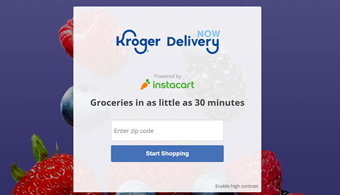They unveiled a range of new retail media-focused products late last month. The enhancements include brand storefront capabilities–which are both free to create and fully shoppable–as well as a suite of new digital display tactics. Ben & Jerry’s, Breyers, and Tillamook were noted as advertisers poised to take advantage.
While these new features and tactics are nice additions, their retail platform is no different from any other. Advertisers looking to capitalize on the type of first-party audience Instacart has amassed–younger, female-leaning, suburban-centered, etc.–will line up to access it. Just like with any other retail media effort, the audiences sell themselves if there are advertisers interested in reaching them.
However, unlike most retail media networks, Instacart isn’t attached to a retailer. Retailers have suppliers. Retailers hold inventory. Retailers sell products. Instacart isn’t a retailer.
Instacart provides a service to retailers (and, in turn, a retailer’s consumers). It’s a valuable service, but still a service nonetheless. This means that Instacart is in the–you guessed it–service industry.
This begs the question: How are Instacart’s retail media efforts viewed by the retailers they partner with? Despite the delivery-based relationship being symbiotic, one would think these newer efforts might be viewed more as parasitic–especially through the eyes of the retailers. At the root of it, a brand interested in buying digital space on one of Instacart’s retailer sites is likely to have interest in buying space on Instacart’s site as well.
Take Kroger for example. Their retail media arm–Kroger Precision Marketing (KPM)–offers both on- and off-site media tactics that utilize their wealth of audience data. Kroger also has the advantage of being heavily driven by loyalty cards. Roughly 96 percent of in-store transactions can be tied to their Kroger Plus card, which can be tied directly to individual consumers and households. It’s a compelling selling point, the idea of knowing your consumer. Put simply, if a brand sells in Kroger, they’re likely to find multiple KPM audiences that either align with (or expand upon) their key audience(s).
Kroger has also gone to exceptional lengths to make their audience data as pristine as possible. They know their offering (from a tactical perspective) is similar to other retail media efforts. There are some areas of differentiation (keyword-less search campaigns, transactional outputs via Roku, etc.), but overall, it’s the same basic formula: digital, social, search, email and in-store tactics to advertisers (both endemic and non) willing to pay for them.
Getting it to Your Door
As noted, Instacart is in the service industry. They provide a service to Kroger, among other retailers. They deploy an app-based, gig economy-driven collective of personal shoppers that bridge the gap between your local store and straight to your door.
Most grocery chains still have a sedentary mindset. Even when purchasing online, the closest most grocery store chains will come to your doorstep is, well, their own doorstep. The growth of BOPIS–especially earlier in the pandemic–has forced them to oblige by picking/packing orders for consumers. However, they sure as sugar won’t bring these orders to a consumer’s doorstep.
Focused on the Shelves
Since the inception of grocery, the largest daily undertakings have been ensuring that product arrives and shelves are stocked. This includes sourcing, warehousing, distribution, stocking, and more. And with each grocery location carrying upwards of 60k SKUs, one can understand the amount of inherent complexity associated with managing such a process. However, with all the focus on the miles traversed to get products on shelves, they never seemed to put much thought into the most important mile of all: the last one.
The Amazons and Walmarts of the world forced their hand, though. Amazon Fresh took the retail giant’s impressively complex supply chain practices and applied them to the grocery industry. Walmart, being the United States’ largest grocery chain, soon followed suit and offered free, same-day grocery delivery via Walmart+. Smaller grocery chains (smaller being a relative term) were forced to find a way to offer the same.
Grocery and The Last Mile
This is where Instacart comes in. They provide an immediate stopgap to cover that last mile for any grocery chain unable to close the loop on fulfillment. Before the pandemic, it could have been seen as a gimmick to most consumers. But with the shelter-in-place orders and mild levels of distance-related hysteria that permeated throughout 2020, it became a necessity.
The pipes connecting Instacart and grocery chains have existed for some time, but it was the pandemic that ratcheted up the water pressure.
A Potential Conflict
Instacart has become an indelible asset to these grocers. Over the past few years, it’s been an incredibly beneficial relationship for both sides. Instacart has seen its revenue (which tripled to $1.5 billion in 2020) and exposure to the average consumer grow, while the grocers they serve were able to continue driving sales even as the pandemic attempted to close their doors.
But within retail media, the relationship isn’t as copasetic. Instacart and Kroger, for example, are swimming in the same waters, hunting the same prey. All advertiser’s retail media budgets are limited in some way, shape, or form. They can’t fund every retail media network. Choices need to be made.
As it relates to advertising with Kroger or advertising with Instacart, for some advertisers, it might be a percentage breakout. For others, it might be a fork in the road. Either way, Kroger must be wary that their piece of the pie is tied so closely to one of their partners. On the flip side, Instacart has made no bones about its future plans around retail media.
First, But Not the Last
Instacart may have been one of the first service-based platforms to dive into retail media, but they weren’t the last. Since their launch, GoPuff, Shipt, and others have built up retail media networks as well.
GoPuff is unique in that it specializes in both alcohol and snack delivery. Their differentiator revolves around inventory. They don’t–as some assume–personal shop in convenience store aisles. GoPuff has warehouses. They own the inventory and deliver the goods. Instacart focuses solely on the latter. Therefore, a platform like GoPuff falls into a different category that is insulated from potential ire.
Who Flinches First?
It all comes down to the cost of doing business. If Instacart’s retail media revenue continues to grow and they continue to siphon dollars away from their partners, those very same partners might be compelled to build their own in-house version of Instacart. Building out a last mile delivery capability would require a great deal of effort, but it could be done.
If that happens, where does that leave Instacart?
A similar situation exists within the retail media sponsored search realm with platforms like Criteo and Citrus. They offer bolt-on paid search functionality to behemoths (i.e., Target and Lowe’s) that haven’t found the resources to build their own tech. It’s a great relationship, beneficial to both sides. It’s also a relationship that’s constantly teetering on the brink. For example, if Target decides one day it wants to build out its own in-house search program, where does that leave a platform like Criteo or Citrus?
Instacart’s unrelenting push towards retail media is the embodiment of poking the bear. Kroger has competitors (Walmart, Costco, Albertson’s, etc.) with retail media networks. The retail grocery industry is rife with competition. But how exactly should Kroger view Instacart? They’re not a competitor, they’re a partner. And now that partner is stealing a share of their potential ad revenue. If Kroger does any type of analysis that points to the cost of creating their own last mile offering being less than the revenue lost to Instacart’s retail media efforts, it’s a no-brainer.
And just like with Criteo and Citrus, what is Instacart without its retail partners? An even more pointed question, what happens to a retail media network when it’s no longer attached to a retailer?








